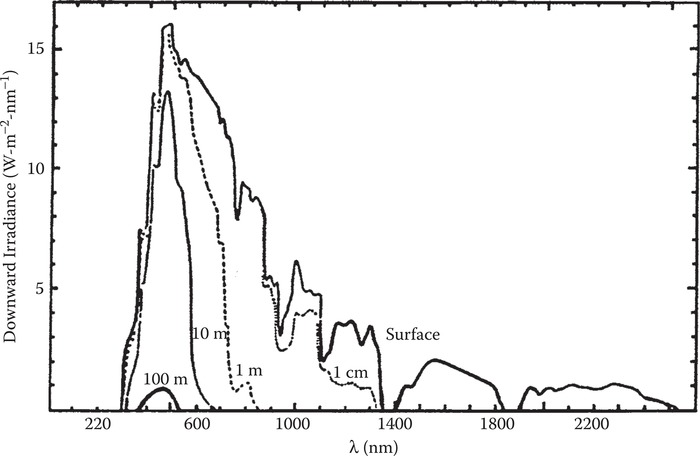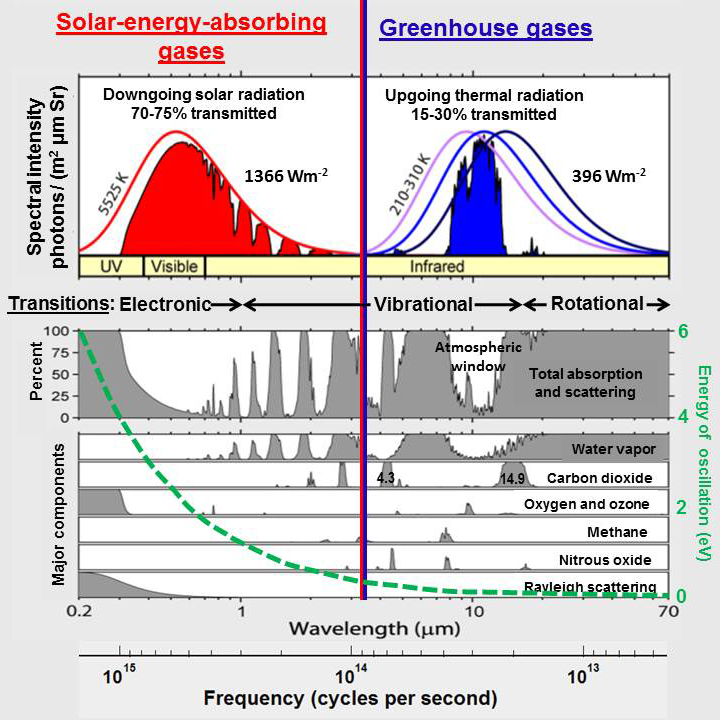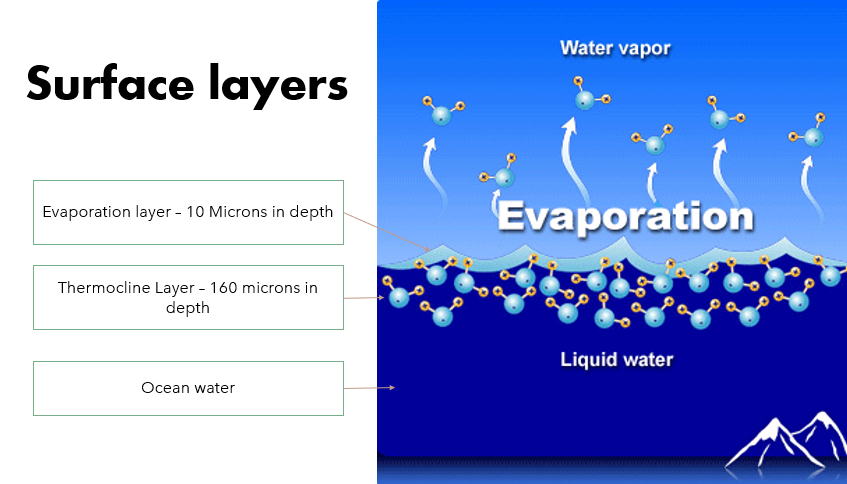Billy_Bob
Diamond Member
In a nutshell, LWIR is incapable of directly warming earth's oceans. (Long Wave Infrared Radiation)
How can this be? It's actually very simple and my friends over at NOAA don't appear to have a grasp on why it cannot happen.
First let's look at the path energy takes from a higher (more excited) molecule to a lower (less excited) molecule. There are two direct methods of energy transfer, radiation and collision. Radiation is the wave of energy propagated outward. Collison is contact transfer of energy.
Anything that can impede these paths can slow or stop energy transfer. This means we must know how each molecule can receive its energy or transmit its energy. In the case of our oceans the WAVELENGTH is imperative to know. How deep into our ocean's energy can penetrate is dependent on its wavelength and the energy it contains.
Below is a graph that shows the Down-Welling Solar Radiation and how it affects our oceans. This is what is generated on the sun. There is overlap between DWSR and LWIR that is generated by the earth's atmosphere (1100nm to 2300nm)


Source: Practical Handbook of Marine Science (routledgehandbooks.com)
The most important thing to look at in this graph is the regions of our oceans that are affected and to what depths they are affected. Does it affect 100m, 10m, 1m, 1cm, or just the surface area? Long Wave Infra-Red radiation starts at about 1.1um and goes out to around 60um. The majority of LWIR is from reradiated energy by the surface or the atmosphere, it does not come from the sun.
This graph above is of Down Welling Solar Radiation and Long Wave Infrared Radiation is to the right as its wavelength is much longer. The next graph shows both the DWSR and LWIR bands of energy. You will also note the eV or energy of oscillations is on the graph below in relation to the wavelength as well. You can see why DWSR will affect the oceans much faster due to the eV (energy) of the wavelength, whereas LWIR has very little energy.


The next thing we are to look at is the ocean and what barriers there are to its absorption. The evaporation layer or 'skin' of the ocean is about 10 microns in depth. The next layer is a thermocline barrier, which is cooler than the skin and is about 150-160 microns in depth. Remember these masses, as it is important to "mixing" due to wave action and what it is capable of.
Below is a graphic I created. It shows the surface of the ocean. I used the molecular version of the evaporative process for a reason. LWIR is so large of a wavelength that it is absolutely absorbed by H2O in the evaporation layer. It is not possible for it to penetrate our oceans beyond the evaporation layer where it is immediately absorbed and removed by water vapor.


The cooler region below the evaporation layer must be warmed if it is to defeat it. This means that the mass of water in the 10-micron region must amass enough energy to warm a region 15 times its size. We could get into the math here but for laymen it is very evident that this cannot warm it. There is simply insufficient energy to warm the mass being emitted from our atmosphere. Evaporation will not allow a buildup of energy in this layer.
Knowing that energy cannot build up in the evaporation layer, it tells us that even with wave mixing of these layers the amount of potential warming is in the margin of being undetectable, if at all. The 'Thermal Surface Layer' (TSL) is the combination of the evaporation layer and the thermocline barrier.
How can this be? It's actually very simple and my friends over at NOAA don't appear to have a grasp on why it cannot happen.
First let's look at the path energy takes from a higher (more excited) molecule to a lower (less excited) molecule. There are two direct methods of energy transfer, radiation and collision. Radiation is the wave of energy propagated outward. Collison is contact transfer of energy.
Anything that can impede these paths can slow or stop energy transfer. This means we must know how each molecule can receive its energy or transmit its energy. In the case of our oceans the WAVELENGTH is imperative to know. How deep into our ocean's energy can penetrate is dependent on its wavelength and the energy it contains.
Below is a graph that shows the Down-Welling Solar Radiation and how it affects our oceans. This is what is generated on the sun. There is overlap between DWSR and LWIR that is generated by the earth's atmosphere (1100nm to 2300nm)
Source: Practical Handbook of Marine Science (routledgehandbooks.com)
The most important thing to look at in this graph is the regions of our oceans that are affected and to what depths they are affected. Does it affect 100m, 10m, 1m, 1cm, or just the surface area? Long Wave Infra-Red radiation starts at about 1.1um and goes out to around 60um. The majority of LWIR is from reradiated energy by the surface or the atmosphere, it does not come from the sun.
This graph above is of Down Welling Solar Radiation and Long Wave Infrared Radiation is to the right as its wavelength is much longer. The next graph shows both the DWSR and LWIR bands of energy. You will also note the eV or energy of oscillations is on the graph below in relation to the wavelength as well. You can see why DWSR will affect the oceans much faster due to the eV (energy) of the wavelength, whereas LWIR has very little energy.
The next thing we are to look at is the ocean and what barriers there are to its absorption. The evaporation layer or 'skin' of the ocean is about 10 microns in depth. The next layer is a thermocline barrier, which is cooler than the skin and is about 150-160 microns in depth. Remember these masses, as it is important to "mixing" due to wave action and what it is capable of.
Below is a graphic I created. It shows the surface of the ocean. I used the molecular version of the evaporative process for a reason. LWIR is so large of a wavelength that it is absolutely absorbed by H2O in the evaporation layer. It is not possible for it to penetrate our oceans beyond the evaporation layer where it is immediately absorbed and removed by water vapor.
The cooler region below the evaporation layer must be warmed if it is to defeat it. This means that the mass of water in the 10-micron region must amass enough energy to warm a region 15 times its size. We could get into the math here but for laymen it is very evident that this cannot warm it. There is simply insufficient energy to warm the mass being emitted from our atmosphere. Evaporation will not allow a buildup of energy in this layer.
Knowing that energy cannot build up in the evaporation layer, it tells us that even with wave mixing of these layers the amount of potential warming is in the margin of being undetectable, if at all. The 'Thermal Surface Layer' (TSL) is the combination of the evaporation layer and the thermocline barrier.

